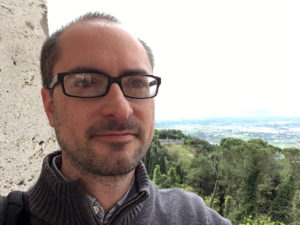Students in Fordham’s MA and PhD programs produce original research of the highest quality, and are encouraged to publish this work when and where it is appropriate during their time in the program. The academic year 2016-2017 saw the appearance of articles by a number of our students in different peer-reviewed volumes and journals. We asked our students who published their work to tell us a little bit about the articles and the writing process and we’ll feature these students and their publications in a short blog series.
This week we report on an article published this past year by History PhD student Jeffrey Doolittle. We recently heard about Jeff Doolittle’s adventures in the archives at the abbey of Montecassino in Italy, where he has been researching medical manuscripts on the earlier middle ages. His article, however, tackles a very different question in a much later period. Entitled “Charlemagne in Girona: Liturgy, Legend and the Memory of Siege” it addresses a liturgy composed for the emperor Charlemagne that was written in a fourteenth-century manuscript. The article was published in The Charlemagne Legend in Medieval Latin Texts, ed. William J. Purkis and Matthew Gabriele, pp. 115-47. Cambridge: D.S. Brewer, 2016.
Jeff wrote to us to describe the process of writing and revising the article:
This article has certainly changed a lot since it began as a seminar paper in Dr. Nicholas Paul’s graduate course on the crusades some six long years ago! In its published form, part of an edited volume by William Purkis and Matthew Gabriele on the Latin legends of Charlemagne, my article provides a brief overview of the cult of St. Charlemagne in Girona, Spain, which was celebrated in the cathedral of the city from the middle of the fourteenth century up until its suppression in the late fifteenth century. Central to Girona’s unique liturgical office was a narrative of Charlemagne’s role as a liberator of the city from the Muslims in the context of a dramatic siege, ultimately aided by the miraculous intercession of Mary. To make matters more interesting, there were no indications from other sources that Charlemagne himself had ever stepped foot in Girona nor had directed any attack against the city; the tradition seems to have been a later medieval development. I focus on the narrative of siege in the article, and argue that the fourteenth-century liturgy’s emphasis on Charlemagne’s imaginary siege of Girona and his triumph should be read against the much more recent and traumatic siege, also at the hands of a French crusading king from the north during the Crusade against Aragon (1284-5), where Girona was also the victim. This project has taken a long journey as it has transformed with Dr. Paul’s help from an inchoate seminar paper to a more focused conference paper given at the International Medieval Conference at a session organized by Drs. Purkis and Gabriele, and finally to a published contribution in their volume. Above all, I am grateful for the guidance and constructive comments at each juncture from many people, all of which helped effect this transformation.

